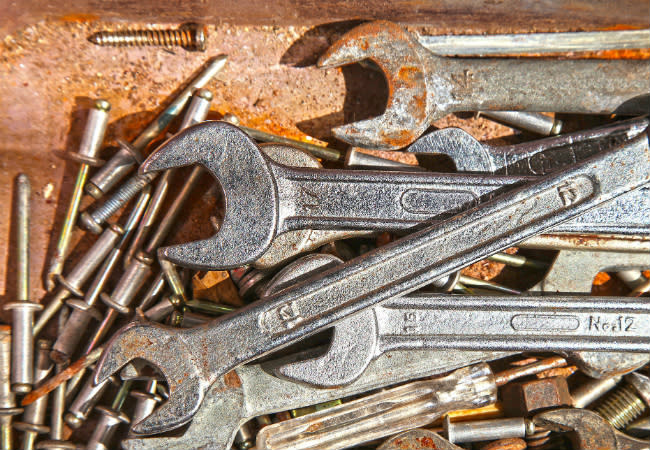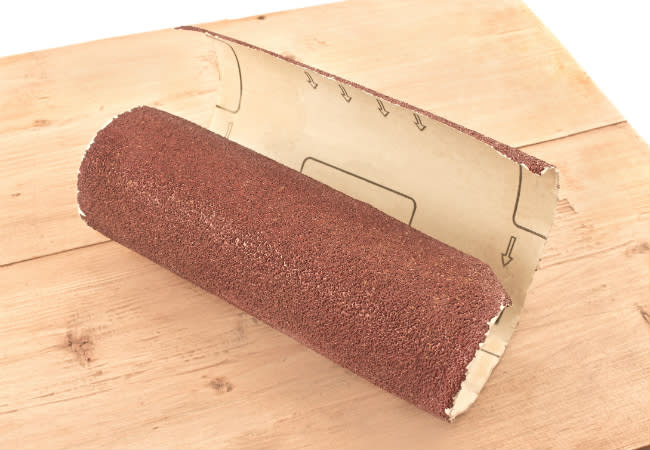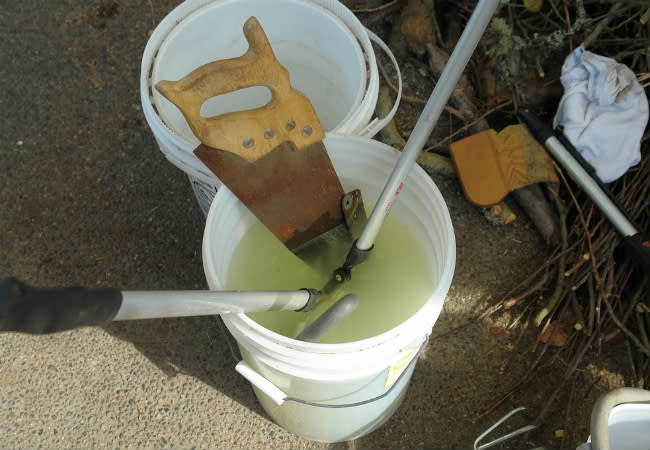How To: Remove Rust from Hand Tools
Has it been a while since your last home improvement project? If your do-it-yourself skills are a little rusty, chances are your tools are too. Without regular use, metal tools are prone to problems. Over time, iron and steel exposed to oxygen and moisture form a chemical reaction called oxidation. The visual evidence of this reaction is the burnt orange speckling that covers your metal possessions. Eventually, too much rust will ruin your tools—giving you yet another excuse to put off those projects. Well, no more excuses! Grab those tools and get to work, because rust is removable. Here we offer two ways to quickly and easily bust that rust.
[inset]
Get Physical: Scour, Scrape, and Sand
If you don’t mind using a little elbow grease, you can physically remove rust with abrasion. Choose an effective scrubbing material when dealing with light to moderate surface rust problems. Deeper rust issues may require more than just muscle, but this physical solution is a good first step.
TOOLS AND MATERIALS
- Dish detergent
- Coarse sandpaper, scouring pad, or steel wool
- Fine sandpaper
- Kerosene (optional)
- Electric drill with wire wheel (optional)
STEP 1
Start by cleaning the rusted tools in soapy water to remove dirt and grease. Then, rinse the tools with water and dry thoroughly.
STEP 2
For light rust, scrub the surface with a scouring pad, sandpaper, or steel wool. Always start with the coarsest abrasive to remove the built-up rust and pockmarks, then switch to a finer grit to smooth out the grooves caused by the coarse grit. If you still see rust, it’s time for a more heavy-duty course of action.
STEP 3 (optional)
For more serious rust problems, coat the surface of the tools with kerosene to function as a cutting lubricant. Wait several minutes. Then, attach a wire wheel to an electric drill to buff away the stubborn rust. Finish off with fine-grain sandpaper to remove any leftover residue. If the surface rust is gone, your work is done. But if the problem persists, you may need a stronger chemical solution.
Try Chemicals: Soak in Oxalic Acid
When you want to save yourself some energy, oxalic acid offers an effective chemical-based treatment for dissolving light to moderate rust problems. This mild acid gets right into joints and crevices to penetrate the problem areas, making it especially good at removing rust in tight spaces and hard-to-clean spots. Just pick up the inexpensive chemical at your local home improvement store to get started.
TOOLS AND MATERIALS
- Goggles
- Rubber gloves
- Dish detergent
- Oxalic acid
- Large plastic container
STEP 1
First, clean the tools with dish detergent and water before you begin so grease and dirt won’t block the chemical process.
STEP 2
Before you pull out any chemicals, don’t forget to strap on a pair of goggles and rubber gloves for protection. Although this is a mild acid, always work in a well-ventilated area to avoid fumes. Mix three tablespoons of oxalic acid with one gallon of water in a plastic container large enough to submerge the hand tools you'll be cleaning. Then, place the tools in the solution and make sure it covers the tools completely.
STEP 3
Soak the tools for approximately 20 minutes, or until the rust is gone. (You may need more time or less depending on the level of corrosion.) Then, rinse, dry thoroughly, and store the tools once more. Additional notes: While there are a variety of different methods for removing unwanted rust, one solution tops the rest: prevention. The following tips will help you stop a rust problem before it starts.
• Remember to always dry your tools immediately after use, and even spray them with a rust inhibitor like WD-40.
• Store your tools in a clean, dry place. Dust attracts moisture, and moisture leads to rust. Yes, you need to dust your house and your toolbox too!
• Keep your toolbox moisture-free. Use silica gel packs (available at your local home improvement store) to absorb excess moisture. Or, use an old-fashioned wooden toolbox instead. The wood will absorb any excess wetness.
• Finally, for maximum protection, invest in a dehumidifier to control the climate and limit the humidity. Beyond saving your metal tools, it will keep you comfortable as you tackle your next to-do with your rust-free equipment.
Related Articles





